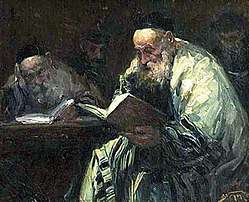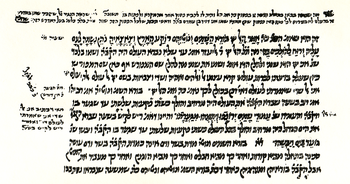Midrash HaGadol
Midrash HaGadol or The Great Midrash (Hebrew: מדרש הגדול), written by Rabbi David Adani of Yemen (14th century), is a compilation of aggadic midrashim on the Pentateuch taken from the two Talmuds and earlier midrashim of Yemenite provenance.[1] In addition, it borrows quotations from the Targums, Maimonides,[2] and Kabbalistic writings,[3] and in this aspect is unique among the various midrashic collections. This important work—the largest of the midrashic collections—came to popular attention only in the late 19th century through the efforts of Jacob Saphir, Solomon Schecter, and David Zvi Hoffmann. In addition to containing midrashic material that is not found elsewhere, such as part of the Mekhilta of Rabbi Shimon, Midrash HaGadol contains what are considered to be more correct versions of previously known Talmudic and Midrashic passages.
| Rabbinic literature | ||||||||||||
|---|---|---|---|---|---|---|---|---|---|---|---|---|
 Talmud Readers by Adolf Behrman | ||||||||||||
| Talmudic literature | ||||||||||||
|
||||||||||||
| Halakhic Midrash | ||||||||||||
|
||||||||||||
| Aggadic Midrash | ||||||||||||
|
||||||||||||
| Targum | ||||||||||||
|
||||||||||||
Discovery and publication
The existence of the Midrash HaGadol was first brought to the attention of Jewish scholarship by Jacob Sapir, who in his Even Sapir (1866) reports seeing a manuscript of the work in the possession of the Chief Rabbi of Yemen.[4] His remarks about the "discovery" are reproduced in Fish (1940),[5] where he describes a work on the entire Pentateuch containing "twice as much as our Midrash Rabbah". (It is worth noting that while this collection was new to European Jewry, it was probably well known to the Jews of Yemen.) The first manuscript was brought from Yemen to Jerusalem and then to Berlin in 1878 by a certain Mr. Shapira, and this Midrash subsequently became the subject of much scholarly attention. There are currently approximately two hundred manuscripts of this work residing in various public and private Hebraica collections, according to the catalog of the Institute of Microfilmed Hebrew Manuscripts.

The Midrash HaGadol on Genesis was first published by Solomon Schecter in 1902. A large portion of Midrash HaGadol on Exodus was then published by David Zvi Hoffmann in 1913. Midrash HaGadol on Book of Numbers was published by S. Fisch in 1940 in a more accessible style than the previous efforts, which were principally arranged for a scholarly audience. More recent editions listed by Strack & Stemberger (1991) are those on Genesis and Exodus by M. Margulies (1967), on Leviticus by E.N. Rabinowitz (1932) and A. Steinsalz (1975), on Numbers by E.N. Rabinowitz (1973), and on Deuteronomy by S. Fish (1972). The Mossad HaRav Kook Institute in Jerusalem has also published a five-volume edition.
Authorship
According to Higger (1934), the work dates to the late 14th century. A discussion of its authorship is provided in Fish (1940), wherein he reviews the evidence in favor of the three then-prevailing opinions regarding authorship of the Midrash HaGadol, variously that it is the work of Rambam, his son Abraham ben Rambam, the author according to Maharitz (an opinion disputed in later generations),[6] or David bar Amram al-Adeni.[7] After discounting Rambam as a possible author, and reviewing some compelling factors in favor of the other two possible authors, Fish (1940) offers the conciliatory hypothesis that the work was composed in the Arabic language by Abraham ben Rambam, and translated into Hebrew by David al-Adeni. While Dr. Fish offers possible explanations for how the work—if indeed authored by Abraham ben Rambam in Egypt—came first to be "lost" and then to be rediscovered in Yemen, Strack & Stemberger (1991) find the attribution to Abraham ben Rambam "only extremely weakly attested," and report that modern scholars almost uniformly attribute the work in its entirety to David bar Amram al-Adeni. S. Fish concedes this as well in his Encyclopedia Judaica article on the topic.
Sources
| Rabbinical eras |
|---|
The Midrash HaGadol contains material from Mekhilta de-Rabbi Shimon, Sifre Zutta, Mekhilta on Deuteronomy, Mekhilta de-Rabbi Ishmael, Sifre, and other unknown midrashic sources. In addition, the midrash makes use of the work of Rambam and Alfasi, as well as many geonic writings,[8] but the sources are never cited—a unique characteristic of this midrash.[9] All these various sources are fused in such a way that the product is a new literary creation in which the original ingredients can frequently not be unambiguously discriminated.
A "Midrash HaGadol that was brought from Aden" is cited by Joseph Shalit Riqueti in Sefer Chochmat HaMishkan (1676), but it is not known whether this is the same as this Midrash HaGadol.
References
- All of the extant manuscripts used in printing the Midrash HaGadol were taken out of Yemen, and/or are in the possession of Yemenite Jewish families. In the Midrash HaGadol`s Introduction to the Book of Deuteronomy, it cites the various manuscripts used in reproducing its printed copy, one belonging to Yosef and Avraham Sharabi; one now in the Hebrew University Library collection; four in the Mossad HaRav Kook library collection; one belonging to the Ben-Zvi Institute library collection; one being in a private collection belonging to Dr. Meir Benayahu; and the last one belonging to the Bodleian Library collection in Oxford, England (opp. add. 4o 124a), all being of Yemenite Jewish provenance. There is another manuscript now in the Berlin Staatsbibliothek Library (Or. 1207), also of Yemenite Jewish provenance, as noted in its colophon. In the Introduction to the Midrash HaGadol (on Numbers, Mossad Harav Kook edition), other manuscripts are also mentioned, one belonging to Azriel Abyadh-HaLivni; another belonging to the late Yisrael Yeshayahu; another to Rabbi Yechiel Shelomo Kessar; another to Rabbi Shalom Tzabari; another to the Rambam Library in Tel Aviv; and yet another to the Dr. Israel Mehlmann Library in Jerusalem, inter alia. Other manuscripts were known to be in the possession of the late Rabbi Shalom b. Yosef Halevi Alsheikh and of the Hibshush brothers in Tel-Aviv, as well as private collections in the hand of the late Mordechai Margulies and of Rabbi Y. L. HaCohen Fishman, as noted in the Introduction to the Midrash HaGadol (on Genesis), Mosad HaRav Kook edition.
- E.g. in Midrash HaGadol on Exodus 30:34 (Mossad HaRav Kook edition), s.v. נטף ושחלת וחלבנה, the glosses note that the quotation used in the Midrash HaGadol on the Holy Incense has been taken directly from Maimonides' Mishneh Torah (Hilchot Kelei HaMikdash 2:4), whose words are these: והשחלת היא הציפורן שנותנין בני אדם במוגמרות, וחלבנה כמו דבש שחור היא וריחה קשה והיא שרף אילנות בערי יון. There are many other scattered excerpts taken from Mishneh Torah, as Zvi Meir Rabinowitz notes in his Preface to the Midrash HaGadol on Numbers (Mossad HaRav Kook edition, p. 8)
- (Oesterley & Box 1920)
- (Fish 1957)
- Midrash HaGadol, on Book of Numbers, Foreword written by Fish, pp.5–ff..
- See infra., note on Avraham Al-Naddaf.
- Avraham Al-Naddaf, in his book, Ḥoveret Seridei Teiman (חוברת שרידי תימן), published in Jerusalem in 1928, pp. 7a-b (letter "gimel"), and which contains an inventory of books of Yemenite Jewish provenance, attributes the book to David bar Amram al-Adeni. See Ḥoveret Seridei Teiman, pp. 14–15 in PDF.
- (Strack & Stemberger 1991)
- (Fisch 1940)
- Fish, Solomon (1957), Midrash Haggadol on the Pentateuch: Numbers (Hebrew), London: HaChinuch.
- Fish, S. (1940), Midrash Haggadol on the Pentateuch: Numbers (English), London: Manchester University Press.
- Higger, Michael (1934), "The Midrash ha-Gadol to Leviticus", Jewish Quarterly Review, 25 (2): 161–170.
- Oesterley, W. O. E.; Box, G. H. (1920), A Short Survey of the Literature of Rabbinical and Mediæval Judaism, New York: Burt Franklin.
- Strack, H.L.; Stemberger, G. (1991), Introduction to the Talmud and Midrash, Edinburgh: T&T Clark, ISBN 978-0-8006-2524-5.
External links
- Midrash HaGadol (on the Book of Exodus), Berlin 1914
- Midrash HaGadol (on the Book of Numbers), Manchester 1940